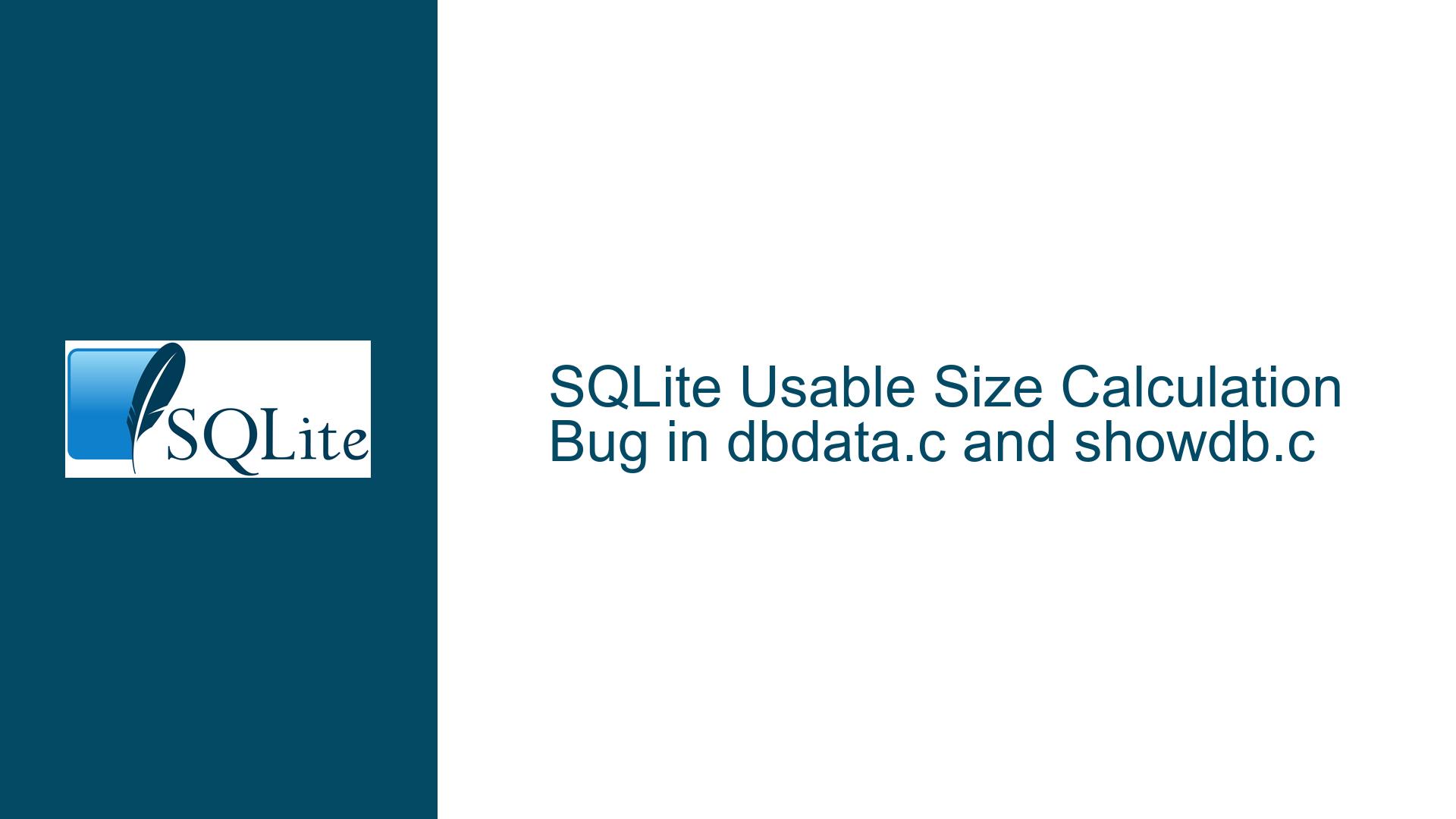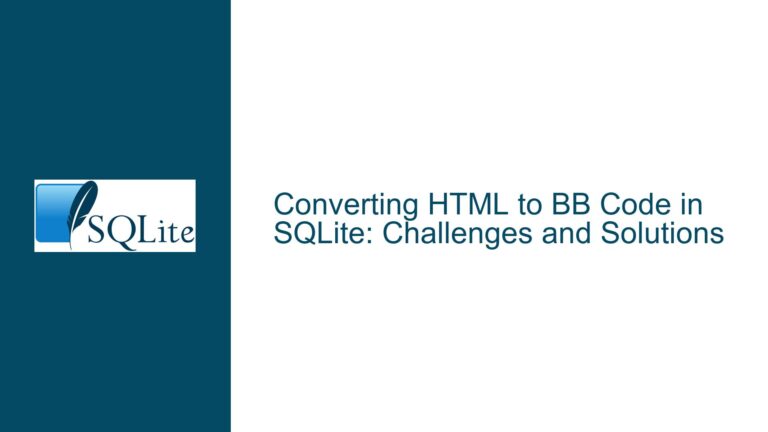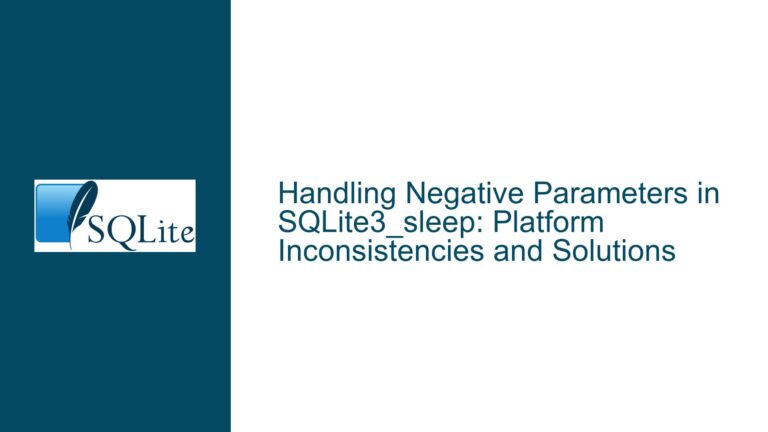SQLite Usable Size Calculation Bug in dbdata.c and showdb.c
Incorrect Usable Size Calculation Leading to Data Loss
The core issue revolves around a bug in SQLite’s dbdata.c and showdb.c files, where the usable size of database pages is incorrectly calculated. This bug manifests when creating a new database with a specific reserved byte size and inserting data that triggers the use of overflow pages. The problem arises because the code directly uses the page size as the usable size when parsing cell data, leading to incorrect handling of overflow pages and subsequent data loss.
When a new database is created with 48 reserved bytes and a table is populated with a large text blob, the .recover command fails to restore the data correctly. Additionally, the showdb utility incorrectly reports the structure of the database, particularly the relationship between b-tree pages and their overflow pages. Specifically, page 3 is identified as a b-tree root page, but the utility fails to acknowledge the existence of an overflow page (page 4) associated with it. This discrepancy indicates a fundamental flaw in how the usable size of pages is calculated and interpreted during data parsing.
The issue is critical because it affects data integrity, particularly in scenarios involving large data inserts and overflow pages. The bug is not immediately apparent in standard operations but becomes evident during recovery or detailed inspection of the database structure. This makes it a silent yet potentially devastating issue for applications relying on SQLite for data storage.
Misinterpretation of Page Size and Usable Size in Cell Parsing
The root cause of the issue lies in the misinterpretation of the page size and usable size during cell data parsing in dbdata.c and showdb.c. In SQLite, the usable size of a page is not equal to the page size; it is the page size minus the reserved bytes. The reserved bytes are used for various purposes, including maintaining the database’s integrity and supporting features like write-ahead logging (WAL). When the code incorrectly uses the page size as the usable size, it leads to incorrect calculations of cell offsets, payload sizes, and overflow page handling.
In the provided example, the database is created with 48 reserved bytes, meaning the usable size of each 4096-byte page is 4048 bytes. However, the code in dbdata.c and showdb.c fails to account for this, leading to incorrect parsing of cell data. Specifically, when parsing the cell on page 3, the code incorrectly interprets the payload size and offset, resulting in the failure to recognize the overflow page (page 4) associated with it. This misinterpretation cascades into data loss during recovery operations and incorrect reporting of the database structure.
The issue is further compounded by the fact that the bug affects both the .recover command and the showdb utility. The .recover command relies on accurate parsing of cell data to reconstruct the database, while the showdb utility depends on it to provide a detailed view of the database structure. The incorrect usable size calculation undermines both functionalities, making it a critical issue that needs immediate attention.
Correcting Usable Size Calculation and Implementing Robust Parsing
To address this issue, the usable size calculation in dbdata.c and showdb.c must be corrected to account for reserved bytes. The following steps outline the necessary changes and their implementation:
Update Usable Size Calculation: Modify the code to calculate the usable size as the page size minus the reserved bytes. This ensures that all subsequent calculations, including cell offsets and payload sizes, are based on the correct usable size. For example, if the page size is 4096 bytes and the reserved bytes are 48, the usable size should be calculated as 4048 bytes.
Revise Cell Parsing Logic: Update the cell parsing logic to use the corrected usable size. This involves recalculating the offsets and payload sizes for each cell, ensuring that overflow pages are correctly identified and handled. For instance, when parsing the cell on page 3, the code should correctly interpret the payload size and offset, recognizing the overflow page (page 4) associated with it.
Enhance Error Handling: Implement robust error handling to detect and report inconsistencies in the database structure. This includes validating the usable size calculation and ensuring that all cells and overflow pages are correctly parsed. If an inconsistency is detected, the code should log an error and, if possible, attempt to recover the data.
Test with Various Reserved Byte Sizes: Thoroughly test the updated code with different reserved byte sizes to ensure that the usable size calculation and cell parsing logic work correctly in all scenarios. This includes testing with large data inserts that trigger the use of overflow pages and verifying that the
.recovercommand andshowdbutility function as expected.Document the Changes: Update the SQLite documentation to reflect the corrected usable size calculation and its impact on cell parsing and overflow page handling. This ensures that developers are aware of the changes and can adjust their applications accordingly.
By implementing these changes, the issue of incorrect usable size calculation in dbdata.c and showdb.c can be resolved, ensuring data integrity and accurate database structure reporting. The corrected code will provide a more reliable foundation for SQLite’s data storage and recovery functionalities, benefiting all applications that rely on this lightweight database.
Detailed Explanation of the Fixes
Correcting Usable Size Calculation
The first step in resolving the issue is to correct the usable size calculation in dbdata.c and showdb.c. The usable size of a page is defined as the page size minus the reserved bytes. In the provided example, the page size is 4096 bytes, and the reserved bytes are 48, resulting in a usable size of 4048 bytes. The code must be updated to reflect this calculation.
In dbdata.c, the usable size is used to determine the offset to the cell content area and the payload size of each cell. The current code incorrectly uses the page size (4096 bytes) instead of the usable size (4048 bytes), leading to incorrect calculations. By updating the code to use the correct usable size, the offsets and payload sizes will be accurately calculated, ensuring that overflow pages are correctly identified and handled.
Similarly, in showdb.c, the usable size is used to parse the cell data and display the database structure. The current code also incorrectly uses the page size, leading to incorrect reporting of the database structure. By updating the code to use the correct usable size, the utility will accurately report the relationship between b-tree pages and their overflow pages, providing a correct view of the database structure.
Revising Cell Parsing Logic
Once the usable size calculation is corrected, the next step is to revise the cell parsing logic in both dbdata.c and showdb.c. The cell parsing logic is responsible for interpreting the cell data, including the payload size and offset, and identifying any overflow pages associated with the cell.
In the provided example, the cell on page 3 has a payload size of 4060 bytes, which exceeds the usable size of the page (4048 bytes). This triggers the use of an overflow page (page 4) to store the excess data. However, the current code fails to recognize the overflow page because it incorrectly calculates the payload size and offset based on the page size instead of the usable size.
By revising the cell parsing logic to use the correct usable size, the code will accurately interpret the payload size and offset, correctly identifying the overflow page (page 4) associated with the cell. This ensures that the data is correctly parsed and that the overflow page is properly handled during recovery operations and database structure reporting.
Enhancing Error Handling
In addition to correcting the usable size calculation and revising the cell parsing logic, it is important to enhance the error handling in both dbdata.c and showdb.c. Robust error handling is essential for detecting and reporting inconsistencies in the database structure, ensuring that any issues are promptly identified and addressed.
The enhanced error handling should include validation of the usable size calculation, ensuring that it is correctly calculated based on the page size and reserved bytes. If an inconsistency is detected, the code should log an error and, if possible, attempt to recover the data. This ensures that any issues with the usable size calculation are promptly identified and addressed, preventing data loss and ensuring data integrity.
Additionally, the error handling should include validation of the cell parsing logic, ensuring that the payload size and offset are correctly calculated and that any overflow pages are properly identified. If an inconsistency is detected, the code should log an error and, if possible, attempt to recover the data. This ensures that any issues with the cell parsing logic are promptly identified and addressed, preventing data loss and ensuring accurate database structure reporting.
Testing with Various Reserved Byte Sizes
To ensure that the corrected usable size calculation and revised cell parsing logic work correctly in all scenarios, it is important to thoroughly test the updated code with various reserved byte sizes. This includes testing with large data inserts that trigger the use of overflow pages and verifying that the .recover command and showdb utility function as expected.
Testing with various reserved byte sizes ensures that the code correctly handles different configurations and that the usable size calculation and cell parsing logic are robust and reliable. This includes testing with reserved byte sizes that are both smaller and larger than the default value, ensuring that the code works correctly in all scenarios.
Documenting the Changes
Finally, it is important to document the changes made to the usable size calculation and cell parsing logic in the SQLite documentation. This ensures that developers are aware of the changes and can adjust their applications accordingly.
The documentation should include a detailed explanation of the usable size calculation, including how it is calculated based on the page size and reserved bytes. It should also include a detailed explanation of the cell parsing logic, including how the payload size and offset are calculated and how overflow pages are identified and handled.
By documenting the changes, developers will have a clear understanding of the corrected functionality and can ensure that their applications are compatible with the updated code. This ensures that the benefits of the corrected usable size calculation and revised cell parsing logic are fully realized, providing a more reliable foundation for SQLite’s data storage and recovery functionalities.
Conclusion
The issue of incorrect usable size calculation in dbdata.c and showdb.c is a critical bug that affects data integrity and accurate database structure reporting. By correcting the usable size calculation, revising the cell parsing logic, enhancing error handling, testing with various reserved byte sizes, and documenting the changes, this issue can be resolved, ensuring a more reliable and robust SQLite database.
The corrected code will provide a more reliable foundation for SQLite’s data storage and recovery functionalities, benefiting all applications that rely on this lightweight database. By addressing this issue, developers can ensure that their applications are more resilient to data loss and that the database structure is accurately reported, providing a more reliable and robust data storage solution.






